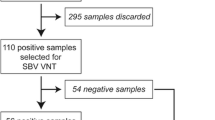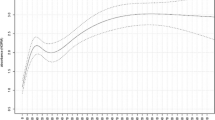Abstract
Serological patterns against Epstein-Barr virus (EBV) specific antigens were determined in 3732 healthy babies and children aged 0–10 years living in the Bari area (South Italy).
IgG antibodies against EBV capsid antigen (VCA) were found in 2713 subjects (72.7%). Seropositivity rates, high in the first semester of life (83.8%), declined between 6 and 12 months (65.6%) and even further between 1 and 2 years (43.8%). After 2 years the frequency of positive children rose progressively reaching steady levels between 5 and 7 years (80.2%) and between 8 and 10 years (81.9%).
IgA antibodies against VCA, IgG anti-early viral antigen (EA) and IgG against virus-associated nuclear antigens (EBNA) were found in 17.9%, 15.9% and 25.7% of the subjects tested, respectively.
IgM anti-VCA were found only in 35 (0.9%) children, but 818 (21.9%) exhibited antibody patterns suggestive of a recent infection: IgG anti-VCA ≥ 1:160 alone or in association with IgA anti-VCA or IgG anti-EA or both.
These results suggest that in this area the primary infection by EBV occur early in life, with immunity to EBV acquired primarily after 4 years.
Similar content being viewed by others
References
Ammatuna P., DiStefano R., Arista S., Sammartano F., Bellia L., Formica P. and Albeggiani A. (1989): Immune status towards Epstein-Barr in a group of Sicilian children - Eur. J. Epidemiol. 5: 219–223.
Biggar R.J., Henle G., Bocker J., Lennette E.T., Fleisher G. and Henle W. (1978): Primary Epstein-Barr virus infections in African infants — II. Clinical and serological observations during seroconversion - Int. J. Cancer 22: 244–250.
Evans A.S. and Niederman J.C. (1989): Epstein-Barr virus. In: Evans A.S. (ed.) - Viral infections of humans: epidemiology and control, 3rd ed., Plenum, New York, pp. 265–292.
Henle G. and Henle W. (1966): Immunofluorescence in cells derived from Burkitt's lymphoma - J. Bacteriol. 91: 1248–1256.
Henle G., Henle W. and Klein G. (1971): Demonstration of two distinct components in the early antigen complex of Epstein-Barr virus-infected cells - J. Cancer 8: 272–282.
Henle W., Henle G. and Horwitz C.A. (1974): Epstein-Barr virus specific diagnostic tests in infectious mononucleosis - Hum. Pathol. 5: 551–565.
Henle G., Henle W. and Horwitz C.A. (1979): Antibodies to Epstein-Barr virus-associated nuclear antigen in infectious mononucleosis. In: Epstein M.A. and Achong B.G. (eds) - The Epstein-Barr virus, Springer, New York, pp. 279–320.
Iones J., Ray J., Minnich L.L., Hicks M.J., Kibler R. and Lucas D.O. (1985): Evidence for active Epstein-Barr virus infection in patients with persistent unexplained illnesses: elevated anti-early antigen antibodies - Ann. Int. Med. 102: 1–6.
Jirillo E., De Simone C., Covelli V., Kiyono H., McGhee Jr. and Antonaci S. (1990): LPS-mediated triggering of T lymphocytes in immune response against gram-negative bacteria - Adv. Exp. Med. Biol. 256: 417–425.
Marklund G., Henle W., Henle G. and Ernberg I. (1986): IgA antibodies specific to Epstein-Barr virus in infectious mononucleosis - Scand. J. Infect. Dis. 18: 111–118.
Nikoskelainen J., Neel E.U. and Stevens D.A. (1979): Epstein-Barr virus-specific serum immunoglobulin A as an acute-phase antibody in infectious mononucleosis - J. Clin. Microbiol. 10: 75–79.
Reedman B.M. and Klein G. (1973): Cellular localization of an Epstein-Barr virus (EBV) associated complement-fixing antigen in producer and non-producer lymphoblastoid cell lines - Int. J. Cancer 11: 499–520.
Simon M., Melzner I. and Bultmann B. (1989): The role of lipoproteins in EBV early antigen induction in Raji cells - Arch. Virol. 107: 43–53.
Sugawara K., Mizuno F. and Osato T. (1972): Epstein-Barr virus-associated antigens in non-producing clones of human lymphoblastoid cells lines - Nature New Biol. 239: 242–243.
Sumaya, Henle W., Henle G., Smith M.H.D. and Leblanc D. (1975): Seroepidemiologic study of Epstein-Barr virus infections in a rural community -J. Infect. Dis. 131: 403–408.
Venkitaraman A.R., Lenoir G.M. and John T.J. (1985): The seroepidemiology of infection due to Epstein-Barr virus in Southern China - J. Med. Virol. 15: 11–16.
Wang P.S. and Evans A. (1986): Prevalence of antibodies to Epstein-Barr virus and cytomegalovirus in sera from a group of children in the People's Republic of China - J. Infect. Dis. 153: 150–152.
Yadaw M.S., Maliga N. and Ablashi D.V. (1987): Development of immunity to Epstein-Barr virus in Malaysian children - Microbiologica 10: 29–35.
Author information
Authors and Affiliations
Rights and permissions
About this article
Cite this article
Leogrande, G., Jirillo, E. Studies on the epidemiology of child infections in the Bari area (South Italy) VII. Epidemiology of Epstein-Barr virus infections. Eur J Epidemiol 9, 368–372 (1993). https://doi.org/10.1007/BF00157392
Issue Date:
DOI: https://doi.org/10.1007/BF00157392




